I thought I was dreaming when, in February 2005, the watercraft we were riding on neared one of the three docking stations on the shores of Boracay island in Malay, Aklan. The color of the sea seemed to change from deep blue tint to a lighter aqua marine hue, and finally to mossy green. I rubbed my eyes for a reality check but the changing colors of the once-inviting Boracay sea was becoming surreal than real - the water near the shore became a kaleidoscope of greenish hues. From the island’s northern tip stretching all the way to the southern tip, the color of the water along the soft white sand beaches has turned to fuzzy mossy green.
Quite noticeable from our outrigger as we moved towards the shoreline was what seemed like a sand belt which was largely covered with slimy brown patches of thick gooey cyanobacterial mats. I learned that the mats grow on nutrients that percolate from land through the sandy beach. The water was indeed turbid.

I have been to Boracay island only thrice – once in 1989, 1992, and then in February 2005. The changes I have seen when I set foot on the island again was a horrendous sight. It looks as if the island was slowly being swallowed by alien vegetation in the form of creeping algae and coliform.
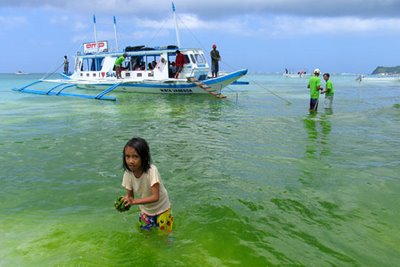
At closer look, the seemingly harmless moss-like substance that has grown on the shores of the island looks like small underwater seaweeds. But once held in ones hand and rubbed on the palms, the slippery fuzzy grime-like substance solidified into mass once it was squeezed-drain of seawater.

I remember the first time I read in the news that coliform and algae had infested the island was in way back 1997, when Fidel Ramos was still the president of the Philippines. The tourism industry was shocked with the evolution of algae and coliform on the island’s shorelines. The tourism industry was gravely affected by it. But since Ramos was an expert in public relations, he was able to rescue Boracay out of the sink hole. It was his Mark Spitz dive infront of news photographers and TV cameramen that saved the island from further media ado.
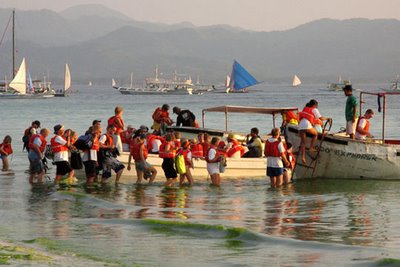
I asked our boatman why this was happening again and all he could tell me in response was that the cold February breeze brought in the green-like substance to the shores. I thought he was kidding me or so it seemed. Was he pulling my leg?

I assumed that perhaps after several years of having green sea water on the island, the occurrence has become such a normalcy to the island’s habitants that they tend to downplay the occurrences.

The abundance of algae was somewhat surprising given that this side of the island was calm and protected. The presence of algae this far off from the shore indicates that nutrient inputs must be considerably high. The boatmen told me that little diving takes place on this side of the island because reefs were not in good condition. The clear evidence of eutrophication suggests that a major source of nutrient-sustaining algae lie in discharges of sewage contaminated groundwater from local populations in the interior villages. Majority of local residents live in the villages in the interior, and the major natural drainage of wetlands and seasonal streams is towards the eastern and western side of the island. Any further sewage drainage into this area, whether from increased local populations, new tourism developments on the north and east, the large hotels and resorts being constructed, or sewage discharge will cause the reefs to deteriorate further unless strict measures are taken to absorb the nutrients before they can reach the sea.
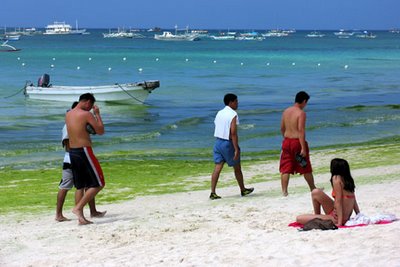
Despite the obvious reasons that the island seemed to be engulfed by a combination of human and animal excrements and chemical wastes, the islanders have treated the issue as simply climatic.

Perhaps, showing grave concern or alarm to the coliform and algae infestation would again negatively affect tourism on the world famous island. I shared the same views with the boatmen and since my primary purpose of visiting the island was work and pleasure, I decided not to give it any serious thought. I spent two days and nights bar-hopping and looking at all forms of human craziness on the island.

When I returned to Manila, I did some research on the Internet to check if there was anything new on the latest colonization of algae and coliform on Boracay. To my surprise, there was no updated report on the bacteria on the island. Have they given up?

The only posting on the Internet that seemed interesting enough to be used as reference data was a supposed draft report submitted by Thomas Goreau, Maya Goreau and James Cervino; three independent marine biologists (I presume) who conducted research studies on the water quality and coral reef health in Boracay, El Nido, Isla Verde, and Balicasag on August 1997.

The three wrote that they conducted research studies on the coral reefs and coastal habitats in several Philippine sites. The field laboratories, they said, had high and low human impact. 18 out of 23 locations (78.3%) showed moderate to high levels of algae growth, indicating that they were currently exposed to elevated levels of nutrients.

Their findings were submitted to the Philippine government on September 1997. It cited that the amount of algae at most sites appeared to primarily reflect sewage runoff from groundwater, but some sites located off uninhabited islands appeared also to be affected by nutrients from episodic upwelling of nutrient-rich deep waters.

The three researchers said that algae overgrowth fertilized by waste-derived nutrients can kill coral reefs. They also warned that infestation of this magnitude could be dangerous to human health.

And how do we solve these problems? The three recommended that coral reef assessment should focus on monitoring and assessing the factors leading to algae proliferation in reef habitats, along with detailed year round monitoring of nutrients in order to identify their source regions, and with a focus on assessing coliform bacteria only in severely polluted areas.

Digging deeper into their report, I noted that the three researchers recommended that research work should be done by greatly expanding the monitoring capability of the Department of Environment and Natural Resources, and the research capability of Philippine marine research institutions.

Protection of the remaining reefs still in good condition will require sustainable programs to develop sewage treatment to tertiary level, and to use dry composting toilets in non-sewered communities.

The three researchers also urged the total ban on the destructive and non-sustainable fishing practices. They said that with these monitoring programs, only then will Philippine reefs be able to safeguard the future of the nation’s fisheries, tourism, biodiversity, and shore protection.

It is said that good coastal zone water quality is central to the health of both bathers and of coral reefs. Swimming in algae and coliform infested waters could offer the swimmers an array of skin disorders like itchiness, allergies and irritations.

But where does this polluting culprit begin? Normally, sewage enters coastal waters when it is released directly into the sea. Sewage pours out to the sea via rivers and gullies, or drains into groundwater from septic tanks and pit latrines which then flows into the sea through sand and limestone.

The 1997 Boracay report which was conducted upon the invitation by then Tourism Secretary Mina Gabor, further stated that sewage effluents carry bacteria and pathogenic organisms which can cause illness or even death, depending on their concentration and virulence. Most sewage microorganisms are killed in the sea by the action of salt, high temperatures, and high light. But the rate of their destruction is greatly slowed if waters are turbid with suspended sediments. The major human health problems which are known to be caused by micro-organisms in sewage contaminated coastal waters include gastrointestinal illness (stomach pains and diarrhea), ear infections, shellfish poisoning, and cholera. Because of the wide variety of medical problems which can be transmitted by coastal waters and the lack of funds to develop and apply specific assays to monitor all of them, a single assay, for coliform bacteria, is generally used as a simple assessment of overall sewage contamination levels.
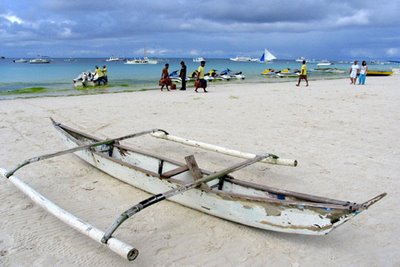
The reason why the researchers tagged coliform (Escherichia coli, or E coli for short) bacteria as an index of pollution was simply because it is a bacterial specie that grows in the human gut. It makes up around 70% of the bulk of human feces. The latest and best introduction to its importance is in a recently published publication by Blattner et al. (1997, Science 277: 1453-1474) of the first complete genome sequence of this bacteria, a study which will result in important new information on how different varieties act. They state: “E coli is an important component of the biosphere. It colonizes the lower gut of animals and as a facultative anaerobe (capable of living both with and without oxygen) survives when released to the natural environment, allowing widespread dissemination to new hosts. Pathogenic E coli strains are responsible for infection of the enteric (stomach and gut), urinary (bladder and kidney), pulmonary (lungs and throat), and nervous system (nerves and brain).”
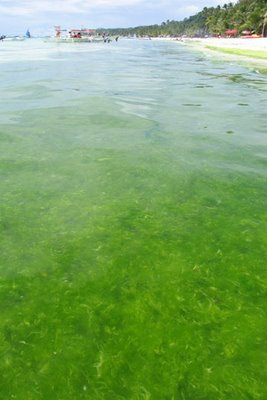
To wrap-up their research, the three researchers reported that indeed the island of Boracay has a beautiful beach which unfortunately shows classic signs of the impacts of uncontrolled and excessive development in advance of developing sewage treatment infrastructure needed to protect its natural beauty. While existing data indicated that water quality is generally adequate for bathing, it is episodically unsuitable, especially at the peak of the tourist season when the beach is calm, and rainfall is low.
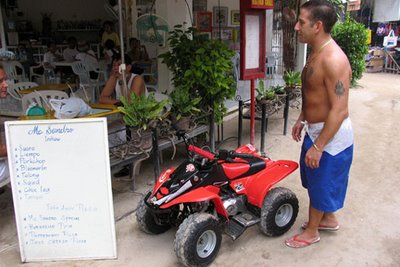
The ecological observations show significant impacts on nearshore and eastern reefs, but western reefs are still in good shape. Protection of the good reefs and restoration of damaged areas will take time once water quality is improved, but that nutrients will need to be reduced to below coral reef eutrophication levels first.
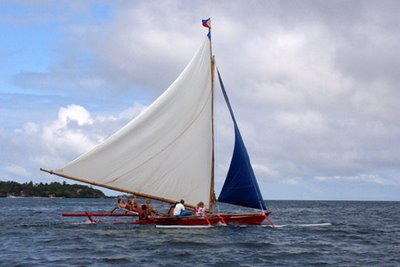
At present the island has little or no suitable sewage treatment for a coral reef area. Most of the resident population of around 10,000 people disposes of their sewage directly into pits in the ground or into surface drainage, which soaks directly through the porous sand and limestone into the sea. While some hotels have septic tanks this is not sufficient to solve the problem. First, there are no facilities to pump out the tanks, so they fill up and the excess flows into the groundwater. Secondly, building extra chambers is not a solution, as the bulk of the nutrients generated by decomposition of wastes go into solution and are not removed in the tanks and are discharged into the ground in the overflow.

Although tourism has uplifted the lives of many island residents, it has also affected the original inhabitants of the island which are the indigenous people of Boracay. They are called ati. The catasthropic toll that tourism could render on the islanders could be beyond restitution once this environmental problem is left unchecked. But I still hope that Boracay would remain as pristine and beautiful as it was two decades ago when only a few backpackers and island-hoppers basked under the sun amid the soft white sand beaches and crystal clear waters of the island.

